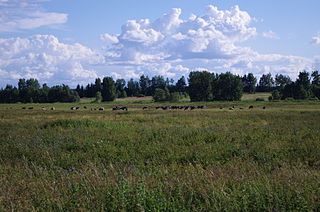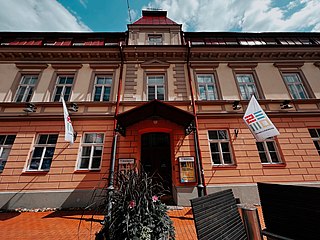
Tartu is the second largest city in Estonia after Tallinn. Tartu has a population of 97,435. It is 186 kilometres southeast of Tallinn and 245 kilometres northeast of Riga, Latvia. Tartu lies on the Emajõgi river, which connects the two largest lakes in Estonia, Lake Võrtsjärv and Lake Peipus. From the 13th century until the end of the 19th century, Tartu was known in most of the world by variants of its historical name Dorpat.

Tartu County is one of 15 counties of Estonia.

Tamme Stadium is a multi-purpose stadium in Tartu, Estonia, located in the district of Tammelinn. First opened in 1932 and reaching its current look in 2011, the stadium is home to Tartu Tammeka and holds 1,638 people.

Haaslava Parish was a rural municipality in Tartu County (Estonia), located southeast from the city of Tartu.

The Estonian National Museum founded 1909 in Tartu is a museum devoted to folklorist Jakob Hurt's heritage, to Estonian ethnography and folk art. The first items for the museum were originally collected in the latter part of the 19th century.

Tartu Cathedral, earlier also known as Dorpat Cathedral, is a former Catholic church in Tartu (Dorpat), Estonia. The building is now an imposing ruin overlooking the lower town. About a third of the cathedral has been renovated. In the part of it that has been renovated is now located the museum of the University of Tartu, which the university also uses for major receptions.

Hanila is a village in Lääneranna Parish, Pärnu County in western Estonia. The village is home to Hanila museum and Hanila church.

Toomemägi is a hill in Tartu, Estonia.

Karlova is a neighbourhood of Tartu, Estonia. It has a population of 8,856 and an area of 2.30 km2 (0.89 sq mi).

Raadi-Kruusamäe, or Raadi for short, is a neighbourhood of Tartu, Estonia. It has a population of 4,498 and an area of 2.83 km2 (1.09 sq mi). Raadi is mainly suburban area.

Supilinn is a neighbourhood of Tartu, Estonia. It is located just north of the city centre, on the right bank of Emajõgi River. Supilinn has a population of 1,863. With an area of 0.48 km2 (0.19 sq mi) it is the smallest neighbourhood of Tartu. Supilinn is especially famous for being a former slum, mostly consisting of 1–2 floored wooden apartment buildings.

Tähtvere is a neighbourhood of Tartu, Estonia. It has a population of 2,989 and an area of 2.50 km2 (0.97 sq mi).

Ülejõe is a neighbourhood of Tartu, Estonia. It has a population of 8,226 and an area of 3.02 km2 (1.17 sq mi).

Tartu Toy Museum is the biggest toy museum in the Baltic States, located in Tartu, Estonia. It displays over 5000 toys from its vast collection and has several interactive toys for the visitors to try out, as well as a playroom for children. In 2005 the film puppets exhibition was opened in the courtyard house, exhibiting film puppets made in Estonia over the last 50 years, props and sketches of animated movies.

The Estonian Sports and Olympic Museum, founded in 1963 and modernized in 2020, is the largest sports museum in the Baltic states. The museum is located on Rüütli street in Tartu, Estonia. Before 2016, Estonian Sports and Olympic Museum was named Estonian Sports Museum.

The Tartu Art Museum is a state-owned museum of art located in Tartu, Estonia. It was founded in 1940 on a private initiative by the members of local art school Pallas. This is the largest art museum in Southern Estonia.

University of Tartu Old Observatory or Tartu Old Observatory is an observatory in Tartu, Estonia. Tartu Observatory was an active observatory from 1810 to 1964. The building now serves as a museum and belongs to the University of Tartu Museum.

Main building of Tartu University is the main building of the University of Tartu. This building is one of the most notable examples of classical style in Estonia.

University of Tartu Art Museum is an art museum in Tartu, Estonia. It is founded in 1803 and considered to be the oldest art museum in Estonia. The museum is located in Main building of Tartu University. The museum is a branch of University of Tartu Museum. The chief of the museum is Mariann Raisma.

University of Tartu Natural History Museum is a natural history museum in Tartu, Estonia. The museum is affiliated with Tartu University.




















